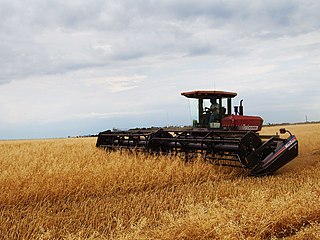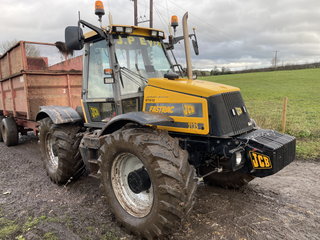Related Research Articles

A threshing machine or a thresher is a piece of farm equipment that threshes grain, that is, it removes the seeds from the stalks and husks. It does so by beating the plant to make the seeds fall out.

The modern combine harvester, or simply combine, is a versatile machine designed to efficiently harvest a variety of grain crops. The name derives from its combining four separate harvesting operations—reaping, threshing, gathering, and winnowing— to a single process. Among the crops harvested with a combine are wheat, rice, oats, rye, barley, corn (maize), sorghum, soybeans, flax (linseed), sunflowers and rapeseed. The separated straw, left lying on the field, comprises the stems and any remaining leaves of the crop with limited nutrients left in it: the straw is then either chopped, spread on the field and ploughed back in or baled for bedding and limited-feed for livestock.

Propulsion transmission is the mode of transmitting and controlling propulsion power of a machine. The term transmission properly refers to the whole drivetrain, including clutch, gearbox, prop shaft, differential, and final drive shafts. In the United States the term is sometimes used in casual speech to refer more specifically to the gearbox alone, and detailed usage differs. The transmission reduces the higher engine speed to the slower wheel speed, increasing torque in the process. Transmissions are also used on pedal bicycles, fixed machines, and where different rotational speeds and torques are adapted.

A continuously variable transmission (CVT) is an automatic transmission that can change seamlessly through a continuous range of gear ratios. This contrasts with other transmissions that provide a limited number of gear ratios in fixed steps. The flexibility of a CVT with suitable control may allow the engine to operate at a constant RPM while the vehicle moves at varying speeds.

Threshing, or thrashing, is the process of loosening the edible part of grain from the straw to which it is attached. It is the step in grain preparation after reaping. Threshing does not remove the bran from the grain.

A swather, or windrower, is a farm implement that cuts hay or small grain crops and forms them into a windrow. "Swather" is predominantly the North American term for these machines. In Australia and other parts of the world, they are called "windrowers". They aid harvesting by speeding up the process of drying the crop down to a moisture content suitable for harvesting and storage.
New Holland is a global full-line agricultural machinery manufacturer. New Holland agricultural products include tractors, combine harvesters, balers, forage harvesters, self-propelled sprayers, haying tools, seeding equipment, hobby tractors, utility vehicles and implements, and grape harvesters.

CLAAS is an agricultural machinery manufacturer based in Harsewinkel, Germany, in the federal state of North Rhine Westphalia. Founded in 1913 by August Claas, CLAAS is a family business and one of the market and technology leaders in harvesting technology. It is the European market leader in combine harvesters and considered as world market leader in self-propelled forage harvesters. The product range also includes tractors, balers, mowers, rakes, tedders, silage trailers, wheel loaders, telehandlers and other harvesting equipment as well as farming information technology. CLAAS employs around 11,500 employees worldwide and reported a turnover of roughly 3.9 billion euros in the 2019 financial year. About 78.5% of sales are generated outside of Germany.
The Gleaner Manufacturing Company is an American manufacturer of combine harvesters. Gleaner has been a popular brand of combine harvester particularly in the Midwestern United States for many decades, first as an independent firm, and later as a division of Allis-Chalmers. The Gleaner brand continues today under the ownership of AGCO.

The JCB Fastrac is a high-speed agricultural tractor series manufactured by JCB Landpower, part of the JCB group.

Agricultural machinery relates to the mechanical structures and devices used in farming or other agriculture. There are many types of such equipment, from hand tools and power tools to tractors and the countless kinds of farm implements that they tow or operate. Diverse arrays of equipment are used in both organic and nonorganic farming. Especially since the advent of mechanised agriculture, agricultural machinery is an indispensable part of how the world is fed.

Claas Lexion is a series of combine harvesters, manufactured by Claas in Harsewinkel. An American version called Lexion was produced by Claas Omaha Inc. in the United States.

The Matador Gigant, initially called Matador, is a self-propelled combine harvester produced by the German agricultural company Claas in Harsewinkel. The Matador Gigant is the largest combine harvester of the Matador series, the smaller Matador Standard was introduced afterwards. Approximately 35,000 units of the Matador series combine harvester were made from 1961 to 1969.

The Fortschritt E 516 is a self-propelled combine harvester made by VEB Mähdrescherwerk Boschofswerda/Singwitz. It was developed in the late 1960s and first half of the 1970s, and after extensive testing in 1975, it was put into series production in 1977. In 1983, the E 516's second generation, the Fortschritt E 516 B was introduced. It was discontinued in 1988 in favour of its successor, the Fortschritt E 517.

The S-4 «Stalinets», is a self-propelled combine harvester, made by several different combine harvester plants in the former Soviet Union, from 1947 until 1955. In 1955, the modernised variant, called the S-4M, was introduced; it was put out of production in 1958. In total, 29,582 units were built. In former East Germany, the S-4 combine was built under licence by the IFA as the Fortschritt E 170 series, from 1954 until 1967. Unlike the original S-4, which is powered by an otto engine, the Fortschritt E 170 series combines were all powered by a diesel engine, and some of them came with a chaff waggon rather than a straw waggon.

The Fortschritt E 512 is a self-propelled combine harvester that was made by the East-German manufacturer VEB Mähdrescherwerk Bischofswerda/Singwitz, and sold under the Fortschritt brand. It is the first Fortschritt combine harvester that has been solely developed in the GDR. The E 512 succeeded the Fortschritt E 170 series. At the time of its introduction in the late 1960s, the E 512 was a modern, sought-after combine harvester that could compete well with high-performance combines made in Western countries, such as the Clayson 140 and the Claas Senator. In total, 51,412 units were made from 1968 until 1988, which makes the E 512 the East German combine harvester with the highest production figure.

The Fortschritt E 514 is a self-propelled combine harvester, that was made by the East-German manufacturer VEB Mähdrescherwerk Bischofswerda/Singwitz in Singwitz, and sold under the Fortschritt brand. It is the successor to the Fortschritt E 512, which it did not manage to replace – the E 514 was produced alongside the E 512 from 1982 until 1988.
The Fortschritt E 510 was a self-propelled combine harvester, developed in the early 1960s by the East-German Fortschritt combine. It was a heavy modification of its predecessor, the Fortschritt E 170 series. Several E 510 combines were made for testing purposes; however, the tests which were conducted in the 1963 harvesting season showed that, the E 510 was no improvement over the E 170 series. Despite having developed the E 510 to a point where it was ready to go into series production, the E 510's series production never commenced, and the E 510 was cancelled. Instead, Fortschritt developed a completely new combine harvester, the Fortschritt E 512.

The Fortschritt E 162, also known as the LBH 52 Kombinus, is a tractor-drawn combine harvester, made by the East-German manufacturer VEB Mähdrescherwerk Boschofswerda/Singwitz in Singwitz, from 1952 until 1956. In total, 54 were built. The E 162 proved to be an unreliable combine, and it was soon replaced by the Fortschritt E 170 series.
References
- ↑ Claas S.F. Mähdrescher aus dem Baujahr 1956 - Historische Landmaschinen Diedenbergen
- 1 2 "Claas-Mähdrescherhistorie". Archived from the original on 2016-09-11. Retrieved 2016-09-18.
- ↑ Brochure 1955, P.1
- ↑ Brochure 1955, P.2